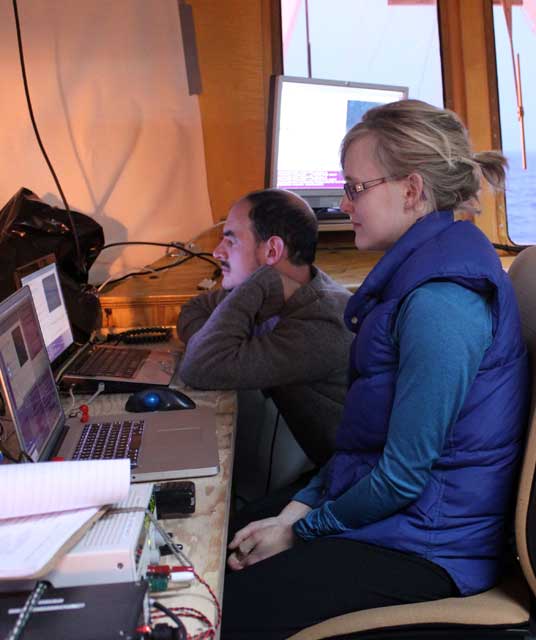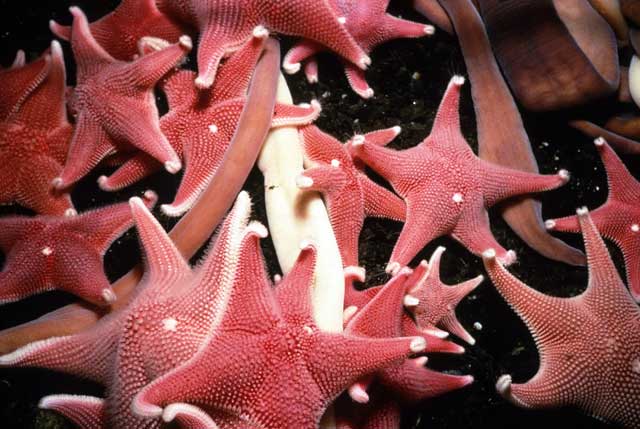Invasive speciesScientists assess threat of king crab populations off Antarctic PeninsulaPosted August 1, 2014
Hold the hot butter. The discovery of hordes of crabs along the continental slopes of the western side of the Antarctic Peninsula in recent years may appear to be a gastronomic boon – but not in the way most people would assume. Large populations of king crabs, first detected less than a decade ago, have scientists concerned that the seafloor organisms along a large swath of the continental shelf may be under threat from the voracious crustaceans. “I’m specifically interested in what damage these king crabs will do to the ecosystem should they get onto the [continental] shelf,” said Kathryn Smith The seafloor, or benthic, communities may have evolved over millions of years without the presence of such predators, leaving them especially vulnerable to the durophagous (skeleton-breaking) king crabs. Richard Aronson Loss of such a unique time capsule of biological life could be devastating, according to Aronson. “This study goes to the heart of the problem of globalization of marine life,” he said recently by e-mail. “Antarctica boasts functionally unique marine communities populated by endemic species. Injecting predators that might not have been components of those communities for thousands or millions of years would ‘normalize’ those communities – drive them to become similar to benthic communities elsewhere in the world ocean. “We could be on the verge of losing a part of what makes Antarctica so unusual, so wild, and so beautiful,” he added. At risk are a range of species, from ubiquitous brittlestars to bivalves like clams to starfish and sea urchins. In 2007, researchers, including project collaborator Sven Thatje That was partly the catalyst for a 2010-11 expedition led by Thatje, in collaboration with Aronson and James McClintock 
Photo Credit: Maggie Amsler
Scientists watch the live feed of images arriving from SeaSled from the seafloor.
Scientists captured more than 140,000 high-resolution images using a towed undersea instrument package called SeaSled from Woods Hole Oceanographic Institution (WHOI) “It has taken months, years, to go through them all,” Smith said. “We are getting great images. The colors down there are really amazing.” Photographic evidence from an unrelated project during the previous year, called LARISSA The N. yaldwyni population was reportedly reproducing, estimated at more than one million crabs in a 146-square-mile area in water deeper than 950 meters. The movement of the cold-blooded crustaceans from the deeper ocean depths onto the shallower continental slopes appears to be related to the warming of the shallower waters in the region. “They are controlled by temperature to some degree,” Smith said. The king crabs are generally found in waters around 1 degree Celsius, she said. Water temperatures around the Antarctic Peninsula have been increasing in recent years from global warming, according to Smith, potentially allowing the king crabs to move into areas where they may have been absent for millions of years. Surface waters in the Antarctic can be as low as minus 1.8 degrees Celsius. In some areas, the crabs are only a couple hundred meters deeper than the continental shelf break. “We are looking at this problem from every angle to ask what might be limiting the crabs from climbing onto the shelf,” Aronson said. “So far, we do not see any factor that would keep them from outer-shelf habitats.” One hypothesis is that the crabs are still in the process of extending their range, according to Aronson. They could be at or near the shelf-break in just a few years. “That idea is testable by repeated monitoring of sites over the next years to decades,” he said. Scientists with the British Antarctic Survey (BAS) 
Photo Credit: Richard Aronson
Sea stars and other benthic organisms are possibly under threat by invading king crabs.
Aronson conceded that the populations of king crabs may have been on the continental slope for a long time. But that doesn’t change the threat to the organisms on the continental shelf. “From the standpoint of the benthic communities on the shelf, however, the issue is semantic; the point is that the arrival of shell-breaking predators on the shelf could have a devastating impact on those communities,” he said. The consequences of what could happen to the ecosystem around the Antarctic Peninsula aren’t just theory. In the 1960s, scientists with the Soviet Union introduced the red king crab, Paralithodes camtschaticus, to the Barents Sea near the Arctic. A native of the Bering Sea, the red king crab found itself right at home in the Barents Sea. Its population spread rapidly, consuming everything in its path. Smith said more data are needed not only to answer questions about the origin of the king crabs in the peninsula, but also to answer basic questions about its ecology. Researchers had intended to collect specimens during the 2013 research cruise, but an anomalous sea ice year limited ship operations. She is scheduled to lead another team in February 2015 back to Marguerite Bay and other sites to catch specimens of P. birsteini to assess the health and fecundity of the populations. The researchers will attempt to find females with eggs that they can keep alive for further analyses back in their labs. Other measurements of the king crabs, which can grow up to 10 centimeters, will include the size of their claws – an indicator of the type of prey they could crush. An assessment of stomach content will also give the researchers a better idea of exactly what the crustaceans are feeding on. “They decimate everything in the areas where they have been introduced,” Smith said of the various king crab species around the world. NSF-funded research in this article: Richard Aronson, Florida Institute of Technology, Award No. 1141877 |



For USAP Participants |
For The Public |
For Researchers and EducatorsContact UsU.S. National Science FoundationOffice of Polar Programs Geosciences Directorate 2415 Eisenhower Avenue, Suite W7100 Alexandria, VA 22314 Sign up for the NSF Office of Polar Programs newsletter and events. Feedback Form |



